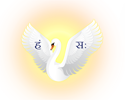– Rajahamsa Swami Nityananda Giri
Burning Desires And Attaining Liberation Through Breath Technique ( Prāṇakarma)
Wise does not Pray for Mortal Objects
Desires are bondage and if you have no desire then it is liberation, only this much is to be understood. These desires are the impurities of the mind, mano mala. When these impurities are reduced and new impurities are not created in the mind then the person moves towards liberation, and that is nirvāṇa. This is the teaching of Lord Buddha. Bhagavatī Śruti, the Vedas, also teaches this to us. The Lord of Death, Yama, while teaching to Naciketā says,
parācaḥ kāmānanuyanti bālāḥ te mṛtyoryanti vipatasya pāśam;
atha dhīrā amṛtatvaṁ viditvā dhruvamadhruveṣviha na prārthayante.
(Ka. U.: 2-1-2)
Ignorant man follows his desires, he is extrovert and he is caught in the vast trap of death. And the intelligent ones knowing the immortality, the eternal among the mortal objects does not pray for anything here.
Rajahamsa Swami Nityananda Giri further adds –
The natural tendency of our mind is to be extrovert, for that reason we are always trapped in thirsts, desires. To such men like us Bhagavatī Śruti is addressing as bālāh, child, or the ignorant ones whose discriminating intellect has not been developed. This is the reason we wish to enjoy the objects like sounds, touches etc, and again fall to the trap of death. One who desires the mortal things becomes mortal. In the words of Ṛṣi Patañjali, ‘vṛttisārupyamitaratra’ (Ygs.: 1-4), ones form appears as according to ones mental tendency. When the seer is not established in the Self, at that time his form appears according to his tendency. Since all our mental attitudes are running after the impermanent objects even if it is the post of the King of gods, Indra pada (may be this post is in this world), our existence that finds its own form in those impermanent objects attains to death again and again. The net of this death is very large since the objects are many. This is the reason we are not attaining the peace of mind, equanimity. But one who is intelligent, has discriminating ability, whose knowledge is holding the Truth by experience; he only knows the immortality, knows his Own Form, he separates the eternal from the non-eternals. He knows that the ignorance, the desires and the actions arising out of the ignorance are the form of world, are the form of death. For that reason he does not fall on the trap of desires. Lord Vāsudev Śrīkṛṣṇa has also said this,
labhante brahmanirvāṇamṛ ṣaya kshīṇakalmaṣāḥ;
chinnaddaidhā yatātmānaḥ sarvabhūtahite ratāḥ. (Sh. Bg.: 5-25)
The seers whose sins have been thinned out, whose doubts has been eradicated, whose senses and mind are under control by the Knowledge of the Self, who are engaged in the benefit of others, they achieve liberation in the form of the Brahman.
kāmakrodhaviyuktānāṁ yatīnāṁ yatacetasām;
abhito brahmanirvāṇaṁ vartate viditātmanām. (Sh. Bg.: 5-26)
The wise men whose minds are free from lust and anger, those who know the Self, they are absorbed by the liberation in the form of the Brahman.
For liberation the sins and the doubts must have to be thinned out, one should be free from lust and anger. These require burning the desires, control of the organs and control of the mind. This would lead to liberation in a process of purification of the mind, attainment of knowledge and renunciation of actions or fruits of actions.
Only this much is the knowledge, to know the Self that has no desires, no volitions of the mind, not to engage the mind on the sense objects. But how this will happen? We read this, listen this, knew this in our mind and intellect but are not established in this. Some spiritual practitioners say, ‘ we read and analyze the content of the scriptures, we receive the knowledge but this does not last long’. What is the meaning of such sayings? Meaning is this knowledge is on the surface of our mind; this has not gone deep within and that is the reason this knowledge does not last long, because we are not practicing this in a proper way. Then what is the proper way?
Worshiping The Prāṇa Is The Way
Lord Vāsudeva has said,
sparsānkṛtvā bahirbāhyāṁścakshuścaivāntare bhruvo;
prāṇāpānau samau kṛtvā nāsābhyantaracāriṇau. (Sh. Bg.: 5-27)
One has to shut all the sense objects like sound etc, the gaze is to be fixed in the place between the eyebrows, and the exhalation and the inhalation are to be balanced that are moving within the nose.
So all the sense objects or all the desires for enjoyments are to be shut down, such thoughts are not to be contemplated in the mind. How? By fixing the gaze between the eyebrows means one has to practice the concentration in Ājñā Cakra, in the place between the pituitary and the pineal, the life force is to be fixed in that place. That again, how? By balancing the exhalation, prāṇa and the inhalation, apāna, within the nostrils means inside the body. This technique one has to learn and practice. This is the way to control the sense organs and the mind, this is the way to sharpen the intellect, and this is the way to be free from the desires, the anger and the fear. This is known as prāṇavidyā, the knowledge of the prāṇa; this is known as prāṇopāsanā, worshiping the prāṇa. This is Karma-sanyāsa yoga, yoga of renouncing the actions and their results. This is Kriyā-yoga, by doing this action, kriyā, one shall be renounced from the actions. By doing this breath technique the practitioner will know his prāṇa, know the Īśvara who is the First Born, the Hiraṇyagarbha that is the sum total of all the powers of knowledge and all the powers of action.
~*~*~*~
For more details refer to the book – Kriya Yoga : The Science of Life Force by Rajahamsa Swami Nityananda Giri
